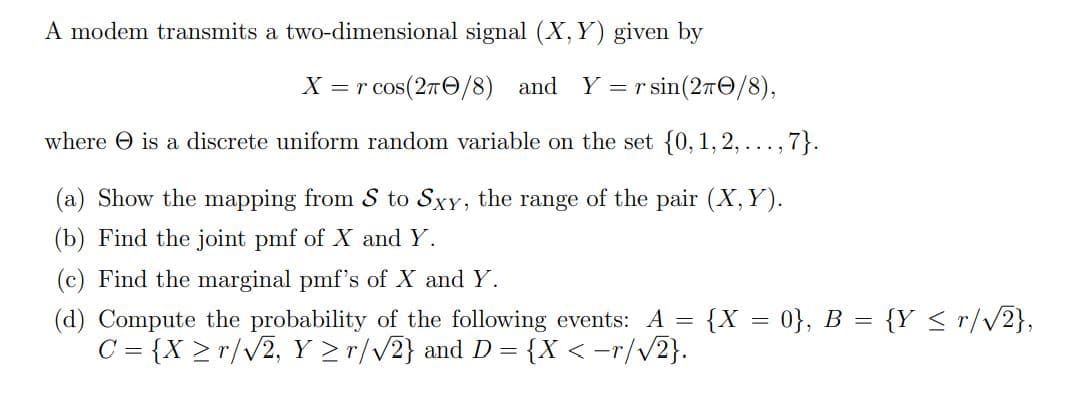X = r cos(27/8) and Y=rsin(27/8), a discrete uniform random variable on the set {0, 1, 2, ..., 7}. he mapping from S to Sxy, the range of the pair (X, Y). he joint pmf of X and Y. e marginal pmf's of X and Y. te the probability of the following events: A = {X = 0}, B = {Y ≤ r/v X≥r/√2, Y ≥r/√2} and D= {X <-r/√2}.
X = r cos(27/8) and Y=rsin(27/8), a discrete uniform random variable on the set {0, 1, 2, ..., 7}. he mapping from S to Sxy, the range of the pair (X, Y). he joint pmf of X and Y. e marginal pmf's of X and Y. te the probability of the following events: A = {X = 0}, B = {Y ≤ r/v X≥r/√2, Y ≥r/√2} and D= {X <-r/√2}.
A First Course in Probability (10th Edition)
10th Edition
ISBN:9780134753119
Author:Sheldon Ross
Publisher:Sheldon Ross
Chapter1: Combinatorial Analysis
Section: Chapter Questions
Problem 1.1P: a. How many different 7-place license plates are possible if the first 2 places are for letters and...
Related questions
Question

Transcribed Image Text:A modem transmits a two-dimensional signal (X, Y) given by
X = r cos(27/8) and Y = r sin (27/8),
where is a discrete uniform random variable on the set {0, 1, 2, ..., 7}.
(a) Show the mapping from S to Sxy, the range of the pair (X, Y).
(b) Find the joint pmf of X and Y.
(c) Find the marginal pmf's of X and Y.
=
(d) Compute the probability of the following events: A
C = {X ≥r/√2, Y ≥r/√2} and D = {X <-r/√√2}.
{X = 0}, B = {Y ≤r/√2},
Expert Solution
This question has been solved!
Explore an expertly crafted, step-by-step solution for a thorough understanding of key concepts.
This is a popular solution!
Trending now
This is a popular solution!
Step by step
Solved in 8 steps with 8 images

Recommended textbooks for you

A First Course in Probability (10th Edition)
Probability
ISBN:
9780134753119
Author:
Sheldon Ross
Publisher:
PEARSON


A First Course in Probability (10th Edition)
Probability
ISBN:
9780134753119
Author:
Sheldon Ross
Publisher:
PEARSON
